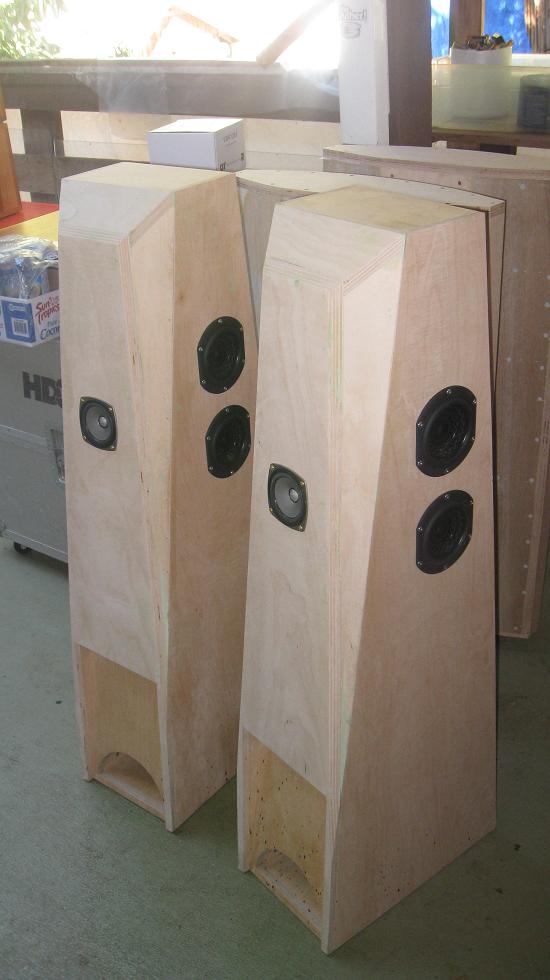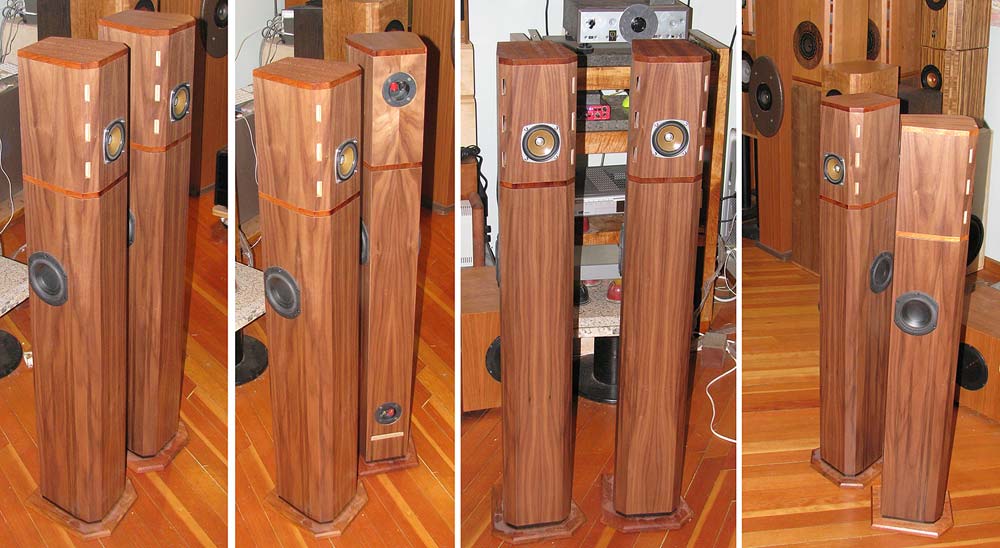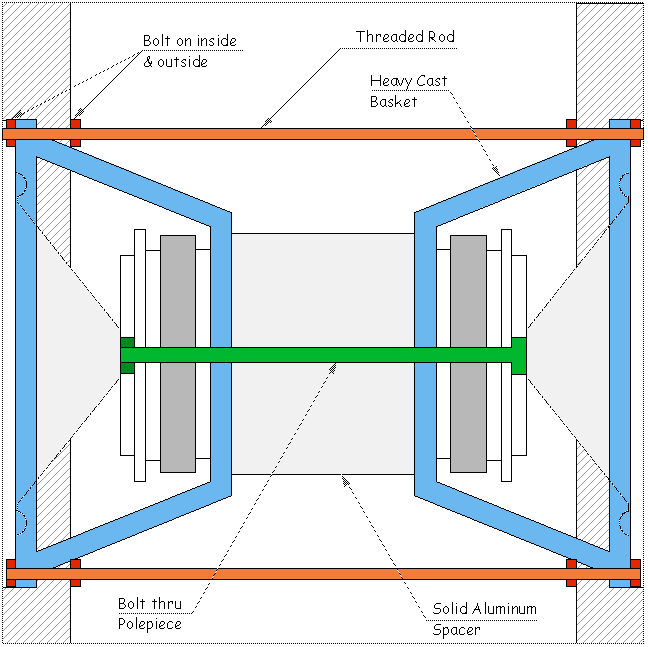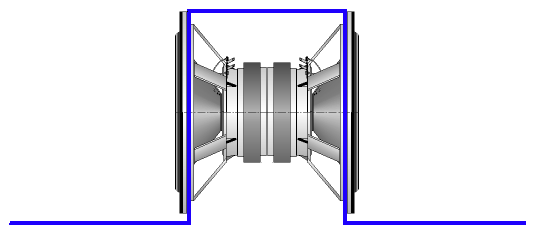or as you said isobaric (unless I am mistaken)
You are mistaken. The woofers are push-push pairs. This is really only practical with side monted woofers in this situation.
Anyone can add a woofer/subwoofer. The beauty of the blade is the way the drivers are physically configures.
These were inspired by th eBlade, but based on FF85wk miniOnken + woofT stand.

dve
Thanks Dave.
More to think about.
So is that to say that all woofers are in phase. Like below?
https://www.audiophysic.com/en/push-push-configuration/
More to think about.
So is that to say that all woofers are in phase. Like below?
https://www.audiophysic.com/en/push-push-configuration/
what are peoples thoughts on making a Kef Blade/Muon clone type thing by using the KEF LS50's and just adding either a sub, or Bass or low mid and bass in a separate box?
Wow a serious question... that is a nice, although it may get lost in this flaming spamalot thread of petty insults and bickering...
As Planet10 said, this is very practical approach. Most high quality small 2-way speakers can really shine if the bass frequencies are removed from their signal path. I would use a pair of subwoofers, and crossover above 100 Hz, probably closer to 150 Hz. It is probably best to position the subs within a few feet of the LS50s. I would use a good DSP crossover such as MiniDSP HD 2x4.
Nice picture. Something i have been doing for decades… and knew about for almost that long before. AFAIK KEF had the first commmercial implemtation in the KEF 104ab II.

From that page. The acoustically in-phase, mechanically out-of-phase with tight coupling of the drivers, the reactive forces of the basket of one driver (almost) cancels the reaction force of the other, dramatically lowering the energy that goes into the cabinet.
dave
In this ‘push-push’ configuration, the forces exerted on the speaker by the two woofers cancel each other out, keeping the cabinet perfectly free of any resonances that could harm sound quality.
From that page. The acoustically in-phase, mechanically out-of-phase with tight coupling of the drivers, the reactive forces of the basket of one driver (almost) cancels the reaction force of the other, dramatically lowering the energy that goes into the cabinet.
dave
Hi Jim. Thanks for your input. I suppose it's a bit like LEGO, and as we all know, similarly to LEGO easy to reconfigure. I have somewhere an analogue crossover that I was just going to try as a make shift thing. Mr Pass has designed a crossover that I have been lusting after and wondered if that would be suitable in the final configuration. Remember though, this proposed setup has to offer better performance than Mezzo Utopia's or NS1000M's ! 🙂 (A big ask I know!).
Thanks to all.
Thanks to all.
Hi Dave. As you said, it seems to offer some very attractive performance gains. I'm actually a bit surprised that there is not a professionally made sub product to do the same thing. Does this configuration halve the VAS and the output? (Or is that only isobaric)?
Thanks to all.
Thanks to all.
No. Enclosure size is doubled vs 1 driver and Vd is doubled.Does this configuration halve the VAS and the output?
Hi Brett. Thanks for the info. I'll take that onboard. It seems to be shaping up to be a very doable thing.
It is. Dave has some excellent drawings that he did years ago that make the mounting concept clear. I don't recall who first brought it to my attention, but it would have been many years ago, as the late djk explained PPSL to me back on AA before diyaudio was very big at all. It wasn't new then, but gave me ideas on how to implement it in that application, though I'd need a drawing to explain, but it worked well in my PA at much higher levels than almost all domestic systems use and the cabs were almost vibration free.Hi Brett. Thanks for the info. I'll take that onboard. It seems to be shaping up to be a very doable thing.
If you think about how your going to implement and physically construct the enclosure for push-push mounting in the design stage, it involves minimal extra effort for very worthwhile results.
There are quite a few.
From the Martin Logan (https://martinlogan.com/en/product/balancedforce-212), their first one had 3 woofers, and KEFs latest little wireless sub for use with the LS 50 wireless (https://eu.kef.com/products/kc62-subwoofer).
I have many drawings of such. Anytime i can use woofers push-push i do.
Here is an example, the woofT under the µFonkenSET:

dave
From the Martin Logan (https://martinlogan.com/en/product/balancedforce-212), their first one had 3 woofers, and KEFs latest little wireless sub for use with the LS 50 wireless (https://eu.kef.com/products/kc62-subwoofer).
I have many drawings of such. Anytime i can use woofers push-push i do.
Here is an example, the woofT under the µFonkenSET:

dave
Dave has some excellent drawings that he did years ago that make the mounting concept clear.
I think the first article i published of a push-push design was this one in 1998/9. https://www.t-linespeakers.org/FALL/rtls/tline.html
This has anillustratoion of over the top coupling: http://www.t-linespeakers.org/FALL/push-push.html

And applied to an OB: https://www.t-linespeakers.org/FALL/dipole.html

dave
Dave,
The first pic I have saved and have reposted many times and the version I have has your name on it. I've used a similar arrangement several times though not with the driver - driver rod as that's hard to implement in off the shelf drivers. I did look at trying it with some of my LAB12s using an enlarged version of Wayne Parnham's thermal plug but I think work got in the way of that. Or maybe it was too expensive to machine. That won't be a problem soon as I have a small mill coming to my new house, mainly for other non audio projects.
As for https://www.t-linespeakers.org/FALL/rtls/tline.html, I don't recall seeing that before today (but maybe I have, some memories are still sketchy post the accident) but as I'm typing I think there was something from Pearl audio around that period. My server is packed for the move, but I'm sure I'll have it as I try to save everything as you never know where you'll get an idea or inspiration and you might as well use it; standing on the shoulders of giants as people say.
The first pic I have saved and have reposted many times and the version I have has your name on it. I've used a similar arrangement several times though not with the driver - driver rod as that's hard to implement in off the shelf drivers. I did look at trying it with some of my LAB12s using an enlarged version of Wayne Parnham's thermal plug but I think work got in the way of that. Or maybe it was too expensive to machine. That won't be a problem soon as I have a small mill coming to my new house, mainly for other non audio projects.
As for https://www.t-linespeakers.org/FALL/rtls/tline.html, I don't recall seeing that before today (but maybe I have, some memories are still sketchy post the accident) but as I'm typing I think there was something from Pearl audio around that period. My server is packed for the move, but I'm sure I'll have it as I try to save everything as you never know where you'll get an idea or inspiration and you might as well use it; standing on the shoulders of giants as people say.
The first pic is using the unique PEARL woofers where a bolt is intended to tun thru the pole-piece. Bill has never done (or advocated AFAIK) push-push.
dave
dave
That makes sense. I'd rather do push-pull but in practical terms, especially if for a commercial design, an exposed driver basket and magnet isn't going to help sales and if enclosed somehow will be more difficult to make, especially if it needs to be pretty.The first pic is using the unique PEARL woofers where a bolt is intended to tun thru the pole-piece. Bill has never done (or advocated AFAIK) push-push.
dave
Barefoot MM27 has 2 woofers bolted together using a wide metal ring around 2 magnets. It has become one of the most popular nearfield / mid field pro studio monitor for last 20 years. I owned them. The bass is very tight and cabinet has almost zero vibration. BTW, the designer, Thomas Barefoot used to be one of the most famous DIY speaker builder before he started his own business.
It is pretty amazing that Thomas Barefoot went through a remarkable transformation when he started his business [prepare for eye-rolling sarcasm] . He was a DIY amateur, which of course means he was a naïve rube, a clueless DIY dork who deluded himself into believing he could design and build something worth listening to... and then he started a company, and abracadabra... as if by magic, he was transformed into one of the enlightened few who hold the secret knowledge of speaker design...
...or perhaps, just maybe, [gasp in disbelief] he was a highly talented DIY designer who knew he could compete and win in the professional studio monitor market.... which means his DIY designs might have been cutting edge as well...
Thank you Plasnu for pointing this out...
...or perhaps, just maybe, [gasp in disbelief] he was a highly talented DIY designer who knew he could compete and win in the professional studio monitor market.... which means his DIY designs might have been cutting edge as well...
Thank you Plasnu for pointing this out...
OK. In a hope to unify people in a common idea, I'd like to ask a speaker related question.Stop the bickering please. DIY is pretty much self explanatory. What more do you need to understand? It's starting to sound like a couple of drunks fighting over the definition of what drunk is. Just stop. Please.
Why do people buy some high cost speakers? (Obviously this is not a contentious issue as they are not DIY in any way). 🙂 Please compare the two speakers below. One is about 20 times the cost of the other.
https://www.stereophile.com/content/wilson-audio-specialties-duette-series-2-loudspeaker
https://www.stereophile.com/content/wharfedale-linton-heritage-loudspeaker
I feel I have and if you are not satisfied with that, tough. As for how you 'feel' as I said previously, your emotional response to anything I, or anyone else says, is your problem. It is not the rest of the world's job to make you feel better about yourself or soothe your emotions.The problem is that you really haven’t made your position very clear
In many cases status or a shiny thing to show off to their friends. Look at exotic cars; driving a Lambo on the roads here at a fraction of it's capability will get you in gaol. Most would be better off in a Camry in terms of what they need and can use, but there is no cache in that.Why do people buy some high cost speakers?
The manufacturing cost of commercial electronics are usually 10% to 20% of MSRP. Smaller the market (=more expensive product), higher margin due to economics. We are comparing 1K with 20K here, so I guess the manufacturing cost would be $200 and $2000. Considering the cost of the unit and enclosure, this is not an unreasonable difference. I'm rather surprised that someone can build this for $200.Please compare the two speakers below. One is about 20 times the cost of the other.
(Edited)
Last edited:
- Home
- Loudspeakers
- Multi-Way
- Expensive speaker DIY projects on the internet- wrong road?